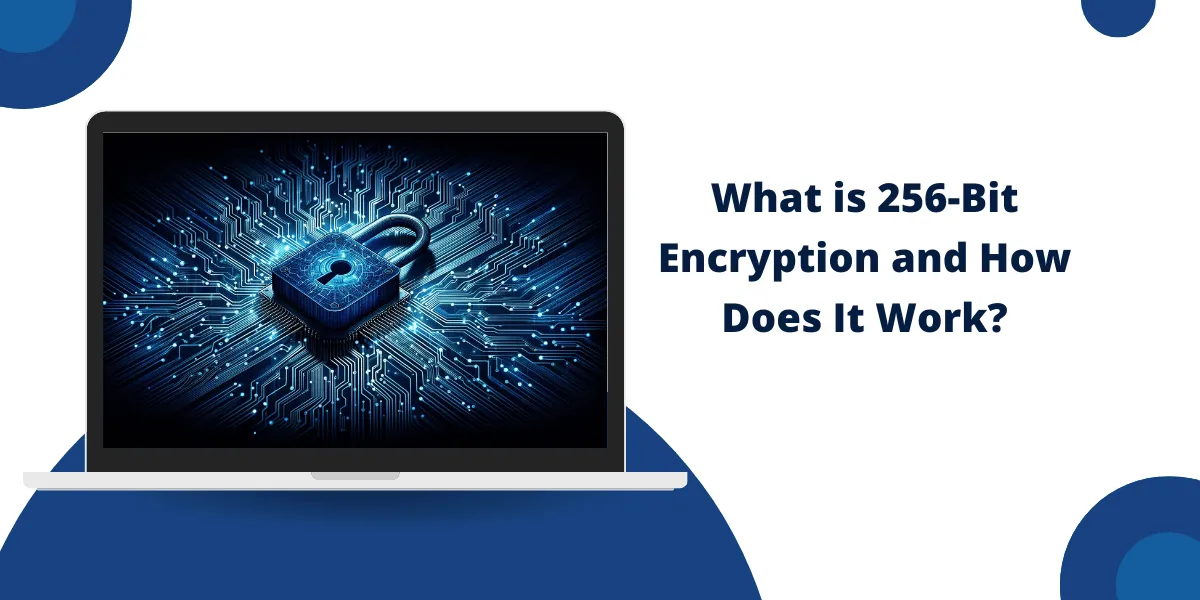Everything You Need to Know About AES-256 Encryption
Encryption is an essential technology that protects sensitive information and provides data security in today’s digital world. It works by scrambling plain text into unreadable ciphertext without decrypting it with a secret key. Over the years, encryption algorithms have evolved to use longer key lengths to make encrypted data more secure against attacks. One of the most robust standards used today is 256-bit Encryption.
But what exactly does 256-bit Encryption mean? How does it work to protect data? And why is it considered one of the strongest encryption levels currently available? This in-depth guide will answer all those questions and more. We’ll start with the basics of Encryption, understand what 256-bit keys are, how they function, and their applications, and compare their security with other key sizes. Let’s get started!
Key Takeaways
- 256-bit Encryption refers to an encryption key length of 256 bits (32 bytes). It provides extremely strong protection for data by making it practically impossible to crack by brute force.
- 256-bit Encryption is used to secure sensitive data in protocols such as AES, SSL, TLS, PGP, cryptocurrencies, password hashing, and more.
- It works by using a 256-bit long key to encrypt data via algorithms like AES. The key obscures the data, making it unreadable without the same key to decrypt it.
- Longer key lengths exponentially increase the number of potential keys, making it impossible for attackers to guess the correct key through brute-force attempts.
- 256-bit keys are extremely secure against brute force attacks with current computing capabilities. However, they may become vulnerable in the future if quantum computing power increases substantially.
- Implementing 256-bit Encryption requires finding the right balance between security and performance. Longer key sizes can impact speed and efficiency.
What Is Encryption and How Does It Work?
Encryption is the process of encoding plain text information into ciphertext that is not human-readable or accessible without decryption. The purpose of encrypting data is to protect its confidentiality and integrity as it is stored or transmitted. Modern Encryption uses complex cryptographic algorithms and secret keys to obscure data.
The basic encryption process follows these steps:
- The plain text message is fed into the encryption algorithm along with a secret key, which is usually a long string of random bits.
- The algorithm performs substitutions and transformations on the plaintext based on the key, scrambling the original data into unreadable ciphertext.
- The resulting encrypted output can only be decrypted back into plaintext with the correct decryption key.
- The receiver feeds the ciphertext and the matching key into the decryption algorithm to reconstruct the original plain text.
The security of encrypted data depends on the secrecy of the encryption keys and the complexity of the cryptographic algorithms used. Stronger algorithms paired with longer key lengths enhance security by making it nearly impossible to decrypt data without the key.
What Are Encryption Key Lengths?
Encryption keys are randomly generated numbers used by encryption algorithms to encode and decode data. The length of the key, measured in bits, determines how many possible keys can exist for the algorithm.
Longer key lengths allow for a greater number of potential key combinations. This exponentially increases the time and computational power required to break the Encryption through brute force attacks.
Some common encryption key lengths are:
- 128-bit: 16-character key with 3.4 x 10^38 possible keys. Provides moderate security.
- 192-bit: 24-character key with 6.2 x 10^57 possible keys. Offers relatively strong security.
- 256-bit: 32-character key with 1.1 x 10^77 possible keys. Extremely high security.
- 512-bit: 64-character key with 3.3 x 10^154 possible keys. Highest security currently used.
256-bit keys are one of the most broadly used lengths today for symmetric encryption algorithms like AES and asymmetric cryptosystems like RSA.
What is 256-bit Encryption?
256-bit Encryption uses an encryption key that is 256 bits or 32 bytes long. This results in 2^256 or 1.1 x 10^77 potential key combinations.
The large key size makes it infeasible to brute force or guess the correct 256-bit key needed to decrypt information. According to IBM, even with a supercomputer guessing 1 trillion keys per second, it would take longer than the age of the universe to crack a 256-bit encryption key!
This level of security is considered unbreakable with current computing capacities. That’s why protocols like AES, PGP, SSL, and others use 256-bit keys as standard. Sensitive data like passwords, financial information, proprietary data, classified documents, cryptocurrency wallets, and more are protected by 256-bit Encryption.
How Does 256-bit Encryption Work?
256-bit Encryption works on the same principle as other key lengths, but the larger key size makes cracking it practically impossible. Here’s a simple example of how it works:
- Let’s take a message “Hello World” that we want to encrypt.
- The encryption algorithm generates a random 256-bit key – for example
125ea17c1434fae1aab8b3c77d9411ee16ad6e3c11b59234adcfc1618a2d7ba32
- The plaintext message and 256-bit key are input into the encryption cipher like AES.
- The algorithm applies substitutions, permutations, and transformations to the data based on the 256-bit key.
- This outputs the encrypted ciphertext – for example:
1011101010111100110010100100111001001110101101100110001101110100010
- To decrypt, the ciphertext is fed into the decryption algorithm along with the original 256-bit key.
- The inverse transformations undo the Encryption and reproduce the original plaintext “Hello World.”
The security stems from the use of a 256-bit key that has an incomprehensibly large number of potential values. Ensuring the key remains secret guarantees the ciphertext can’t be decrypted.
Why is 256-bit Encryption Considered Secure?
There are several reasons why 256-bit Encryption is extremely secure and resistant to attacks:
1. Large key length and complexity
- 256-bit keys have 2^256 possible values which is an astronomically large number (~1.1 x 10^77).
- This high complexity makes brute-forcing the key infeasible in any reasonable time frame.
2. Stronger encryption algorithms
- 256-bit Encryption is used with advanced encryption algorithms like AES, ECC and RSA that have no known weaknesses.
- Attacks like cryptanalysis don’t work against well-designed modern ciphers.
3. Leveraged by widely used security protocols
- Trusted standards like SSL, TLS, PGP, and others use 256-bit Encryption to secure networks, communications, and sensitive data.
- They are supported by reputable security products and services globally.
4. Protection against brute force attacks
- Large key size protects against brute forcing where all possible keys are tried to find the correct one.
- Testing 1 trillion keys per second would take longer than the universe’s lifetime to crack.
5. Quantum resistance
- 256-bit key sufficiently large to resist cryptanalysis even from quantum computers, which can speed up decryption attempts.
Where is 256-bit Encryption Used?
256-bit Encryption is extensively used to protect highly sensitive information across many applications and technologies:
- Advanced Encryption Standard (AES): AES is a symmetric encryption standard used globally. The AES-256 version uses 256-bit keys.
- SSL/TLS: Secure Sockets Layer (SSL) and Transport Layer Security (TLS) protocols use 256-bit Encryption as standard for website and data security.
- PGP & GPG: Privacy protection technologies like Pretty Good Privacy (PGP) and GNU Privacy Guard (GPG) support 256-bit keys.
- Password Hashing: Systems that store login credentials securely use key derivation functions with 256-bit outputs like Argon2 PBKDF2.
- Cryptocurrencies: Major cryptocurrency wallets use 256-bit Encryption to secure coins and transactions.
- PKI Infrastructure: 256-bit keys secure public key infrastructure components like digital certificates and certificate authority communication.
- Securing Databases: Encrypted databases use 256-bit AES to protect sensitive information.
- Full Disk Encryption: Products like BitLocker provide 256-bit AES encryption for entire disk volumes.
- Network & Storage Encryption: Protocols like IPsec and encrypted NAS devices leverage 256-bit strength.
Is 256-bit Encryption Unbreakable?
With current publicly known computing capabilities, 256-bit encryption keys are considered practically unbreakable through brute force. The underlying cryptographic primitives and algorithms that use 256-bit keys have no known weaknesses.
However, future advances in quantum computing could impact the security of Encryption with 256-bit and smaller keys. Quantum computers can run complex calculations significantly faster than classical computers, which gives them the ability to speed up brute-force attacks and cryptanalysis.
Some experts estimate that 256-bit keys may be vulnerable to attacks from sufficiently large quantum computers in the future. So, while 256-bit Encryption is considered unbreakable for the foreseeable future, it’s not future-proof.
A few strategies are being researched to make encryption quantum-resistant:
- Increasing key sizes beyond 256 bits for long-term security against quantum brute forcing. Some standards propose 384-bit and 512-bit Encryption.
- Developing new quantum-safe cryptographic algorithms like lattice-based, hash-based, and code-based cryptography that are inherently resistant to quantum attacks.
- Using a hybrid approach with symmetric 256-bit Encryption protected by an outer quantum-safe algorithm.
- More frequent key rotations and switching between multiple 256-bit keys to limit how much data would be impacted by one key being cracked.
What are the Main 256-bit Encryption Algorithms?
The primary symmetric and asymmetric encryption algorithms that utilize 256-bit keys are:
AES-256
The Advanced Encryption Standard (AES) specified in FIPS 197 uses keys of 128, 192, or 256 bits. AES-256 operates on a fixed block size of 128 bits and uses 14 rounds of encryption processing. It is implemented worldwide to secure sensitive data.
RSA with 2048+ bit keys
RSA asymmetric algorithm can be used with 2048-bit and larger key sizes (e.g., 3072 or 4096-bits), which equates to about 256-bits of symmetric security. RSA-2048 provides the same strength as 128-bit symmetric ciphers.
ECC with Curve25519
Elliptic curve cryptography algorithms like Curve25519 provide 256 bits of security at much smaller key sizes than RSA. Curve25519 keys are only 256 bits in length but have the same security as 3072-bit RSA keys.
DH Group 14/2048
Diffie-Hellman key exchange using 2048-bit group 14 modulus Offers 256 bits of symmetric key strength. Used in protocols like IKE/IPSec VPNs.
ECDH with Curve25519
Elliptic curve Diffie-Hellman key exchange using Curve25519 256-bit keys offers 256 bits of security. It is used in TLS and other protocols.
How Does 256-bit Security Compare to Smaller Key Sizes?
Here’s how 256-bit Encryption compares to smaller key sizes:
- 128-bit Encryption provides moderate security and is faster. However, it is vulnerable to brute force attacks with modern computers and is mostly deprecated except in legacy systems.
- 192-bit Encryption: Offers strong security that is suitable for many uses. 3x slower than 128-bit. NIST recommends 256-bit for top-secret data.
- 256-bit Encryption offers extremely robust security even against state-level adversaries. However, it is twice as slow as 192-bit Encryption, so it is not optimal for performance-critical systems.
- 384-bit Encryption: High security even versus large quantum computers. Significantly slower than 256-bit with very diminishing returns on additional security.
While 128-bit and 192-bit encryption are still commonly found, 256-bit is considered the “gold standard” for security best practices when encrypted data must remain confidential for decades. The performance drawbacks of 256-bit are a reasonable trade-off for sensitive long-term data protection requirements.
Is 256-bit Encryption CPU Intensive?
Encryption with 256-bit keys involves greater CPU usage than with smaller key sizes. Some of the performance overhead includes:
- More computationally intensive encryption/decryption algorithms are required to process larger 256-bit (32 bytes) keys.
- Longer key lengths translate to more encryption rounds for block ciphers like AES. AES-128 uses 10 rounds vs. AES-256’s 14 rounds.
- Asymmetric cryptosystems like RSA also see slower performance with 2048+ bit key pairs versus smaller 1024 or 1536-bit keys.
- Key generation, exchange, and management operations take longer with 256-bit keys.
- Higher memory utilization for storing larger keys and encryption outputs.
The performance impact is definitely noticeable compared to 128-bit Encryption, which is up to 2- 3 times slower in some benchmarks. For non-critical data, lower key sizes may provide sufficient security and better efficiency.
However, for systems like e-commerce, banking, and defense, where security is paramount, the performance trade-off of 256-bit Encryption is easily justifiable. Modern computers and networks can handle it reasonably well in most applications.
Best Practices for Implementing 256-bit Encryption
Here are some recommendations to follow when implementing 256-bit Encryption:
- Use well-known standardized algorithms like AES, RSA, ECC, and TLS that experts have vetted. Don’t try to invent proprietary ciphers.
- Generate keys from a cryptographically secure pseudorandom number generator with sufficient entropy.
- For TLS websites, use 4096-bit RSA keys with AES-256 encryption and SHA-384 hashes for robust security.
- Store encryption keys securely using a hardware security module or key management system, not in application code or configs.
- Enforce key hygiene practices like key revocation, rotation, and destruction when no longer needed.
- Combine 256-bit symmetric Encryption for bulk data encryption with public key Encryption for secure key exchange.
- Balance performance by only using 256-bit Encryption for data that genuinely requires long-term protection.
- Monitor industry recommendations in case quantum-resistant Encryption becomes advisable.
Final Thoughts
256-bit Encryption represents an extremely high standard of security that can protect sensitive data for decades to come. Its large key size makes brute-force encryption practically impossible with current computing power. It is leading encryption algorithms and protocols like AES, RSA, ECC, and TLS that leverage 256-bit keys to secure critical systems and information.
While it comes with some performance drawbacks, 256-bit Encryption provides vital data protection when implemented alongside other security best practices. In the future, increased adoption of quantum-safe cryptosystems will likely become necessary to keep pace with emerging threats over the very long term.
Frequently Asked Questions
What is 256-bit Encryption used for?
256-bit Encryption is used to secure highly sensitive information like classified documents, financial data, proprietary business data, healthcare records, government databases, and other confidential data that require long-term protection.
How secure is 256-bit Encryption?
Based on currently known computing capabilities, 256-bit encryption keys are considered virtually unbreakable by brute force. Exhaustive key searches would take billions of years to crack 256-bit encryption keys.
Is 256-bit Encryption enough for banking?
Yes, 256-bit Encryption is the standard used to secure online banking, credit card payments, cryptocurrency wallets, ATMs, and other financial transactions that require data to remain private.
Is 256-bit encryption overkill?
256-bit Encryption does provide overkill security for low-value data that doesn’t need long-term protection. Based on a risk assessment, 128-bit or 192-bit Encryption may be more appropriate.
Can 256-bit Encryption be cracked?
256-bit encrypted data cannot be cracked with current technology. However, future quantum computers could crack it, given enough time. Some considerations are moving to 384-bit+ Encryption or quantum-safe algorithms.
Is 256-bit Encryption expensive to implement?
256-bit Encryption does not significantly increase costs compared to other key sizes. The algorithms are freely available and built into most modern operating systems, databases, web servers, and applications. However, there are some hardware performance considerations.
What is the difference between 128-bit and 256-bit encryption?
The main difference is the key length: 128-bit (16 characters) vs 256-bit (32 characters). 256-bit has exponentially stronger security with 2^128 times more possible keys, making it resistant to brute force attacks.
What is more secure, AES-128 or AES-256?
AES-256 is significantly more secure than AES-128. AES-256 uses a 256-bit key, making it practically unbreakable for the foreseeable future. AES-128 only has a 128-bit key, which is vulnerable to brute-force attacks.
Does 256-bit Encryption slow down performance?
Yes, 256-bit Encryption involves more computation and can slow down system performance, typically around 2-3x slower than 128-bit Encryption. However, modern computer speeds make this negligible in most applications.

Priya Mervana
 Verified Web Security Experts
Verified Web Security Experts
Priya Mervana is working at SSLInsights.com as a web security expert with over 10 years of experience writing about encryption, SSL certificates, and online privacy. She aims to make complex security topics easily understandable for everyday internet users.



